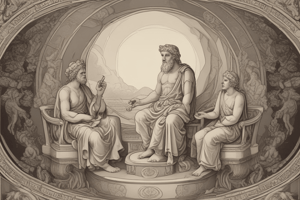Podcast
Questions and Answers
What was the primary function of Kouros and Kore sculptures?
What was the primary function of Kouros and Kore sculptures?
- To depict specific individuals and their unique features
- To represent ideal physical forms and embody concepts such as arete (correct)
- To serve as religious symbols and represent deities in Greek mythology
- To express emotional states and experiences of the human condition
Which type of Greek column is considered the most ornate and detailed?
Which type of Greek column is considered the most ornate and detailed?
- Tuscan
- Ionic
- Corinthian (correct)
- Doric
Which characteristic is NOT shared by both Classical and Hellenistic Greek art?
Which characteristic is NOT shared by both Classical and Hellenistic Greek art?
- Use of contrapposto in figure composition
- Representation of arete through idealized forms
- Emphasis on physical perfection
- Expression of emotional states in sculptures (correct)
What was Alexander's primary motivation for marrying Roxane, a Persian princess?
What was Alexander's primary motivation for marrying Roxane, a Persian princess?
How did Alexander's military campaign differ from traditional Greek warfare?
How did Alexander's military campaign differ from traditional Greek warfare?
According to Plato, what is the difference between the World of Senses and the World of Ideas?
According to Plato, what is the difference between the World of Senses and the World of Ideas?
Flashcards
Sophists
Sophists
Ancient Greek teachers who rejected absolute norms, asserting that norms depend on society.
Socrates' Ethics
Socrates' Ethics
Socrates believed knowledge was key to doing right; ignorance leads to wrongdoing.
Plato's Cave Allegory
Plato's Cave Allegory
Illustrates the difference between the world of senses (perceptions) and the world of ideas (knowledge).
World of Ideas
World of Ideas
Signup and view all the flashcards
Aristotle’s Knowledge
Aristotle’s Knowledge
Signup and view all the flashcards
Archaic Greek Art
Archaic Greek Art
Signup and view all the flashcards
Classical Greek Art
Classical Greek Art
Signup and view all the flashcards
Hellenistic Greek Art
Hellenistic Greek Art
Signup and view all the flashcards
Types of Greek Columns
Types of Greek Columns
Signup and view all the flashcards
Alexander's Administrative Strategy
Alexander's Administrative Strategy
Signup and view all the flashcards
Study Notes
Greek Philosophy
- Sophists: Rejected absolute norms, believing norms are socially constructed. "Man is the measure of all things."
- Socrates: Believed knowledge comes from reason. Wrongdoing stems from ignorance of what is right. Happiness comes from doing what is right.
- Plato: Proposed two realms of reality—the world of senses (incomplete, changing) and the world of ideas (eternal, unchanging ideal forms). The "Allegory of the Cave" represents this.
- Aristotle: Believed reality is based on nature, and knowledge comes from the senses.
Greek Art
- Archaic Art: Kouros/Kore sculptures—male youth, symmetric, balanced, representing an ideal, not individuals.
- Classical Art: Realistic, natural, contrapposto (weight distribution), balanced, no emotion. Focus on physical perfection.
- Hellenistic Art: More emotional, extreme postures, fighting imagery, representations of arete (excellence/virtue/heroism). Depicts naked, idealized figures, athleticism, youth.
- Greek Columns: Doric (simple, thinner towards top), Ionic (scrolls, detailed), Corinthian (most detailed, acanthus leaves, fluted).
Alexander the Great and his Legacy
- Military Campaign: Impressive due to swift conquests despite early doubts about his kingship and rebellions from Greek city-states. Thebes was attacked and destroyed.
- Identity: Alexander identified with Achilles, a legendary hero. He created this image by mimicking Achilles' actions—dancing naked at Achilles' grave.
- Empire Administration: Used marriage alliances (soldiers marrying Persian women) to unite diverse territories. Military force was also employed.
- Treatment of Persian Royal Women: Alexander's marriage to Persian women was part of an administrative strategy for conquering Persia and potentially consolidating power in conquered lands.
- Roxane's Marriage: Married Roxane, a Persian princess. This also contributed to his administrative goals of uniting conquered lands and possibly securing a lineage.
Test Preparation
- Test Format: Multiple choice (5 questions), Greek Art Identification/Discussion, Short Answer (choose 2).
- Modules: Test covers Modules 3 (Golden Age) and 4 (Alexander).
- Time: 40 minutes (or 60 minutes with extended time).
Studying That Suits You
Use AI to generate personalized quizzes and flashcards to suit your learning preferences.




